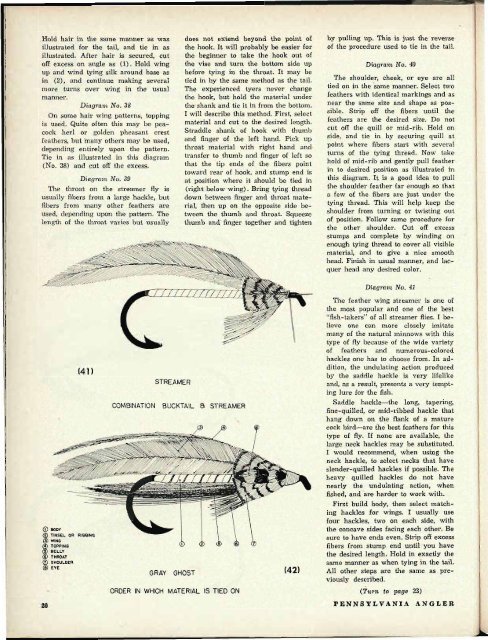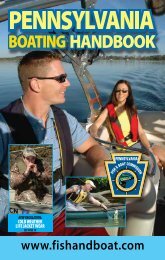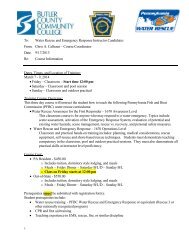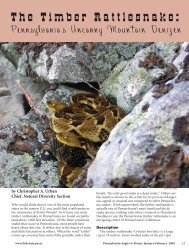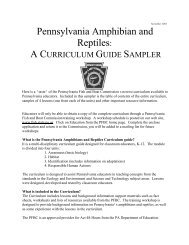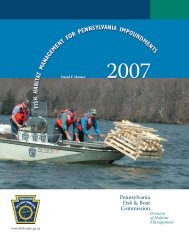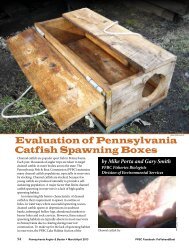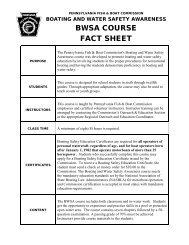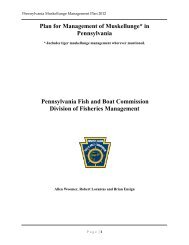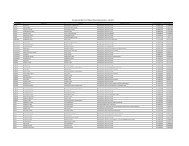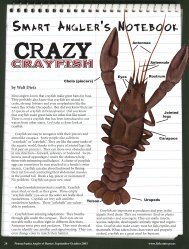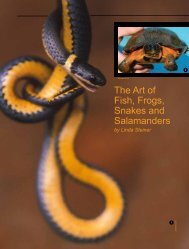pennsylvania angler 1953 - Pennsylvania Fish and Boat Commission
pennsylvania angler 1953 - Pennsylvania Fish and Boat Commission
pennsylvania angler 1953 - Pennsylvania Fish and Boat Commission
You also want an ePaper? Increase the reach of your titles
YUMPU automatically turns print PDFs into web optimized ePapers that Google loves.
Hold hair in the same manner as was<br />
illustrated for the tail, <strong>and</strong> tie in as<br />
illustrated. After hair is secured, cut<br />
off excess on angle as (1). Hold wing<br />
up <strong>and</strong> wind tying silk around base as<br />
in (2), <strong>and</strong> continue making several<br />
more turns over wing in the usual<br />
manner.<br />
Diagram No. 38<br />
On some hair wing patterns, topping<br />
is used. Quite often this may be peacock<br />
herl or golden pheasant crest<br />
feathers, but many others may be used,<br />
depending entirely upon the pattern.<br />
Tie in as illustrated in this diagram<br />
(No. 38) <strong>and</strong> cut off the excess.<br />
Diagram No. 39<br />
The throat on the streamer fly is<br />
usually fibers from a large hackle, but<br />
fibers from many other feathers are<br />
used, depending upon the pattern. The<br />
length of the throat varies but usually<br />
(41)<br />
STREAMER<br />
COMBINATION BUCKTAIL a STREAMER<br />
ORDER IN WHICH MATERIAL IS TIED ON<br />
does not extend beyond the point of<br />
the hook. It will probably be easier for<br />
the beginner to take the hook out of<br />
the vise <strong>and</strong> turn the bottom side up<br />
before tying in the throat. It may be<br />
tied in by the same method as the tail.<br />
The experienced tyers never change<br />
the hook, but hold the material under<br />
the shank <strong>and</strong> tie it in from the bottom.<br />
I will describe this method. First, select<br />
material <strong>and</strong> cut to the desired length.<br />
Straddle shank of hook with thumb<br />
<strong>and</strong> finger of the left h<strong>and</strong>. Pick up<br />
throat material with right h<strong>and</strong> <strong>and</strong>transfer<br />
to thumb <strong>and</strong> finger of left so<br />
that the tip ends of the fibers point<br />
toward rear of hook, <strong>and</strong> stump end is<br />
at position where it should be tied in<br />
(right below wing). Bring tying thread<br />
down between finger <strong>and</strong> throat material,<br />
then up on the opposite side between<br />
the thumb <strong>and</strong> throat. Squeeze<br />
thumb <strong>and</strong> finger together <strong>and</strong> tighten<br />
by pulling up. This is just the reverse<br />
of the procedure used to tie in the tail.<br />
Diagram No. 40<br />
The shoulder, cheek, or eye are all<br />
tied on in the same manner. Select two<br />
feathers with identical markings <strong>and</strong> as<br />
near the same size <strong>and</strong> shape as possible.<br />
Strip off the fibers until the<br />
feathers are the desired size. Do not<br />
cut off the quill or mid-rib. Hold on<br />
side, <strong>and</strong> tie in by securing quill at<br />
point where fibers start with several<br />
turns of the tying thread. Now take<br />
hold of mid-rib <strong>and</strong> gently pull feather<br />
in to desired position as illustrated in<br />
this diagram. It is a good idea to pull<br />
the shoulder feather far enough so that<br />
a few of the fibers are just under the<br />
tying thread. This will help keep the<br />
shoulder from turning or twisting out<br />
of position. Follow same procedure for<br />
the other shoulder. Cut off excess<br />
stumps <strong>and</strong> complete by winding on<br />
enough tying thread to cover all visible<br />
material, <strong>and</strong> to give a nice smooth<br />
head. Finish in usual manner, <strong>and</strong> lacquer<br />
head any desired color.<br />
Diagram No. 41<br />
The feather wing streamer is one of<br />
the most popular <strong>and</strong> one of the best<br />
"fish-takers" of all streamer flies. I believe<br />
one can more closely imitate<br />
many of the natural minnows with this<br />
type of fly because of the wide variety<br />
of feathers <strong>and</strong> numerous-colored<br />
hackles one has to choose from. In addition,<br />
the undulating action produced<br />
by the saddle hackle is very lifelike<br />
<strong>and</strong>, as a result, presents a very tempting<br />
lure for the fish.<br />
Saddle hackle—the long, tapering,<br />
fine-quilled, or mid-ribbed hackle that<br />
hang down on the flank of a mature<br />
cock bird—are the best feathers for this<br />
type of fly. If none are available, the<br />
large neck hackles may be substituted.<br />
I would recommend, when using the<br />
neck hackle, to select necks that have<br />
slender-quilled hackles if possible. The<br />
heavy quilled hackles do not have<br />
nearly the undulating action, when<br />
fished, <strong>and</strong> are harder to work with.<br />
First build body, then select matching<br />
hackles for wings. I usually use<br />
four hackles, two on each side, with<br />
the concave sides facing each other. Be<br />
sure to have ends even. Strip off excess<br />
fibers from stump end until you have<br />
the desired length. Hold in exactly the<br />
same manner as when tying in the tail.<br />
All other steps are the same as previously<br />
described.<br />
(Turn to page 23)<br />
20 PENNSYLVANIA ANGLER


